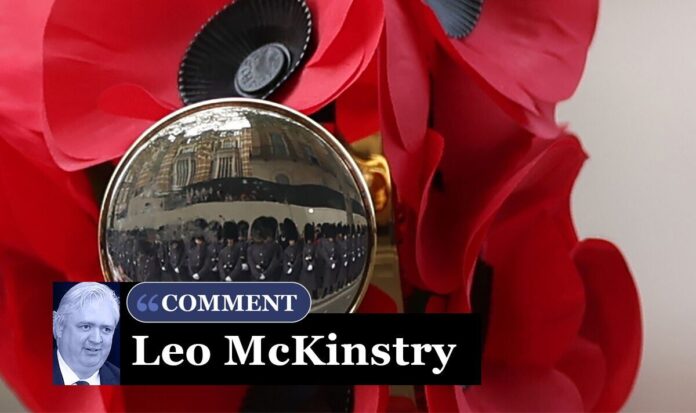The tradition grew out of the Anglo-French ceremonies held at Buckingham Palace in November 1919, including a two minutes silence for the fallen, to mark the first anniversary of the Armistice that brought the brutal First World War to an end. On Armistice Day in 1920, the rituals became much more public and spread nationwide, as the two-minute silence was observed throughout the land and the funeral of the Unknown Soldier was held in front of vast crowds at newly constructed Cenotaph in Whitehall, designed with awe-inspiring simplicity by the brilliant architect Edwin Lutyens.More than a century later, Remembrance Sunday remains as emotive as ever, all its elements combining to form a powerful tribute to the past and present heroes of the armed forces. The main ritual in central London always has a timeless, evocative quality, its sounds and images redolent of our rich history, like the firing of the cannon by the Royal Horse Artillery in nearby Horse Guards Parade to signal the beginning and end of the two-minute silence.Equally rousing are the mournful chimes of Big Ben echoing in the stillness over the capital, heard on a Remembrance Sunday for the first time in five years after the famous Victorian clock underwent a massive restoration programme.Just as striking are the buglers playing the Last Post at the Cenotaph, a valedictory melody that resonates down the ages even though it contains only three notes.Nor could any sentient person failed to be moved on Sunday by the sight of the Chelsea pensioners, all of them in their rich scarlet coats, many in wheelchairs, some with tears in their eyes, advancing past the Cenotaph or by the 10,000 other veterans marching along the same route, full of dignity and comradeship despite the passage of the years. ‘There was an added poignancy to this year’s Remembrance Sunday’ (Image: Getty)But there was an added poignancy to this year’s Remembrance Sunday, for it took place little more than two months after the death of Her Majesty the Queen. Reflecting her own wartime service in the ATS as a driver and Royal Family’s ties to the armed forces, Elizabeth II always treated the event with a profound reverence,Indeed, in her long reign of 70 years, she only missed the ceremony seven times, and on Sunday her benign but revered presence could still be felt.Yet the new King, leading the homage of the nation for the first time, carried out his role to perfection. Dressed in his Field Marshal’s uniform, with sorrow and respect etched on his face, it was obvious that he was deeply moved both by his sense of duty to the fallen and the memory of his beloved mother, but that only added to the emotion of the occasion. The main event in London was mirrored by ceremonies throughout our nation (Image: Getty)In another personal tribute to his mother, his magnificent wreath incorporated the racing colours of purple and gold he had inherited from her.The other members of the Royal Family were just as dignified. The King was followed by the Queen Consort’s equerry Captain Edward Anderson, who laid a wreath on her behalf, as she looked on from a balcony at the Foreign and Commonwealth Office, the new Princess of Wales by her side, a picture of sombre elegance.Once the other Royals, including the Prince of Wales and the Princess Royal, had done their duty, the politicians did theirs, led by Rishi Sunak, whose presence in the top job is a symbol of changing Britain.It has to be said, however, that the line-up of ex-Prime Ministers in Whitehall was a reminder of the recent instability in British politics. John Major and Tony Blair served 17 years between them. In the last six years, we have had no fewer than five different premiers.There were other poignant features of the day. This year is the 40th anniversary of the Falklands War, so on Sunday’s march past included 400 veterans from the South Atlantic Medal Association, while the Ukrainian war is a reminder of the need for continuing vigilance against oppression. The line-up of ex-Prime Ministers in Whitehall was a reminder of the recent instability in politics (Image: Getty)As the Defence Secretary Ben Wallace, himself a veteran of the Scots Guards put it, ‘All of use will be thinking of those brave Ukrainians who are fighting for their very own survival to defend freedom and democracy, just as UK and Commonwealth soldiers did in both World Wars.’As always, the main event in London was mirrored by ceremonies throughout our nation, from Edinburgh to Eastbourne.At Enniskillen in Northern Ireland, in a welcome emblem of reconciliation, the Irish Taoiseach Micheal Martin and Northern Ireland Secretary Chris Heaton-Harris jointly laid wreaths at the town’s war memorial, the scene of one of the darkest IRA atrocities in 1987 when 11 people were massacred in a bomb blast. Once the Royals, including had done their duty, the politicians did theirs (Image: Getty)But probably the most uplifting moment on Sunday came when the severely disabled ex-paratrooper Ben Parkinson, at a Remembrance ceremony Doncaster, stood on his prosthetic limbs for the two-minute silence having lost both his legs and suffered both a broken back and brain damage in a bomb attack in Afghanistan.Parkinson embodies the best, defiant spirit of the armed forces.It is an outlook that was also encapsulated on Sunday in the prayer made by the Bishop of London Dame Sarah Mullaly during the religious service at the Cenotaph, in which she urged us ‘to give and not to count the cost, to fight and not to heed the wound.’That is exactly what our veterans did, which is why it is right to honour them fulsomely.


